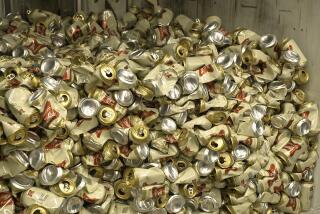Belgian Brewers Look Abroad in Efforts to Offset Declining Domestic Consumption
- Share via
CHIMAY, Belgium — Father Thomas is a portly, ruddy-faced monk who for 36 years has lived secluded in a hilltop monastery. Gerard Fauchey is a wisecracking executive helping run a billion-dollar business empire from Beijing to British Columbia.
An odd couple for sure, but they have one thing in common. They are key figures in a brewing industry that for centuries has supplied this grateful nation with some of the world’s most distinctive beers.
Now the monk and the multinational are looking further afield, to serve far-flung ale lovers unhappy with the pale, watery, aluminum-wrapped products that dominate world beer markets.
“We’re not just selling our beer, but also our beer culture,” said Jan de Brabanter, external affairs director of the Confederation of Belgian Brewers.
“When consumers encounter our beers they should be aware they are unlike any others.”
Here they make beer with cherries, raspberries, even peaches. They have rich, dark Trappist ales brewed by the likes of Father Thomas that pack triple the strength of regular beer.
They have beers spiced with coriander and orange peel. They have red beers, brown beers, white beers and golden beers.
These are not advertising gimmicks, but often age-old recipes that let Belgians claim their pint-sized nation is to beer what France is to wine.
But times are changing. Sixty-years ago, the average Belgian gulped down 200 liters a year. Now it’s a mere 106 liters.
Breweries blame everything from anti-drunk-driving campaigns to aggressively marketed sodas.
They aren’t too worried because profits have been maintained by increased consumption of more expensive specialty beers. But to counterbalance stale home sales, Belgian beer-makers are looking at bubbly foreign markets.
From 1980 to 1994, exports doubled to 460 million liters, a quarter of the country’s total production.
*
Leading the way is Interbrew, which last year swallowed up Canada’s John Labatt Ltd. to become the world’s fourth-largest beer producer. Only Anheuser-Busch and Miller of the United States and Heineken of the Netherlands make more suds.
“We have established ourselves as one of the leaders of the industry,” says Fauchey, Interbrew’s external relations director, at the company’s high-tech brewery in the central city of Leuven.
Fauchey outlines an export and investment strategy spreading rapidly from traditional Western European markets into China, Eastern Europe and the Americas.
Interbrew’s biggest brands here are Stella Artois and Jupiler--variations on the light, golden Pilsener lager that spread from Bohemia (now part of the Czech Republic) in the 1800s to become the world’s dominant beer type.
But Belgium’s export push is spearheaded by specialty beers.
Interbrew already scores well across Europe with its Leffe range of strong beers of monkish inspiration and its Hoegaarden “white beer”--a spicy, lemon-tinted thirst-quencher with roots in the Middle Ages.
Like other Belgian brewers, Interbrew hopes to cash in on the growing interest in specialty brews generated by the microbrewery boom in the United States.
From 1992 to 1994, Belgian beer exports to the United States almost doubled to 1.5 million liters.
“Canadians and Americans are suckers for history,” said Fauchey. “If you can claim brands that date back to the Middle Ages, you’re going to do better than a microbrewery that started last week.”
That message is not wasted on Father Thomas and his fellow monks at Notre Dame de Scourmont Abbey outside this little town that has been making beer for 134 years.
“In America it sells in chic restaurants,” said Father Thomas, the abbey’s brew master, as he slowly poured a copper-tinged Chimay into its heavy stemmed goblet.
“They call this the Burgundy of beers.”
Producing 100 million liters per year, the Chimay brewery is a minnow compared to Interbrew. Yet export manager Michael Weber says proudly that the three Chimay brews--named Red, White and Blue for the color of the caps--account for a third of all Belgian beers sold in the United States.
That’s despite the uneven treatment Belgian specialty beers get there. Belgian brewers wince at reports of American bars serving Trappist beers iced or expecting customers to knock them back direct from the bottle.
In a country where beers are given the respect reserved elsewhere for vintage wines, each brew has its own distinctive glass. Many are best at cellar or room temperature, not chilled.
Interbrew’s Fauchey acknowledges that Belgians have their work cut out to pass on such subtleties to the American mass market.
“Basically, the United States has no beer culture,” he said. “Beer is drunk as an alternative refreshment to Coca-Cola or 7-Up.”
More to Read
Sign up for Essential California
The most important California stories and recommendations in your inbox every morning.
You may occasionally receive promotional content from the Los Angeles Times.













